Make it cheaper or more beautiful? Aluminum radiators with bottom, diagonal and side connections
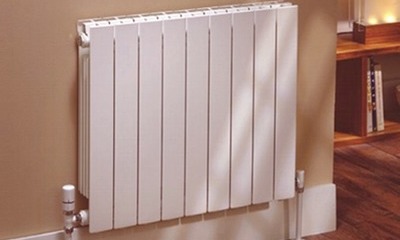
Aluminum radiators - modern and inexpensive alternative cast iron "accordions" of Soviet production.
Advantages aluminum batteries are considered: high heat output; modern and aesthetic design; variety of sizes and light weight, which ensures ease of installation in a variety of conditions; the ability to manually adjust the heating system.
Aluminum batteries demanding on the purity of the coolant. Therefore, they are convenient for autonomous heating systems.
Connection diagrams for aluminum heating radiators
From the type of heating system and the efficiency of the selected connection scheme correct and safe operation depends devices. First of all, the type of wiring is determined: single-pipe or double-pipe.
Single-pipe or "Leningrad"
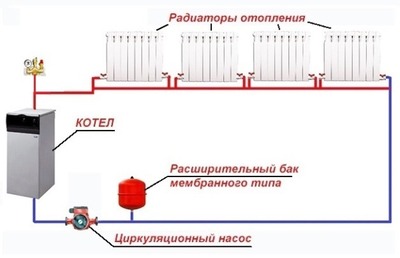
Option more economical, if you consider the installation costs. Radiators are connected to the network in series, the coolant enters the input of each subsequent device, passing through the previous one.
The outlet of the latter is connected to a riser (in multi-storey buildings) or to a heating boiler.
This type of wiring is also called "Leningradka". more often used in high-rise buildings due to cost-effectiveness. However, it is characterized by a number of shortcomings. This is the impossibility of separately regulating the heat output of radiators - a regulator installed on one will set the parameters for the entire system. And the large length of the network with a series connection leads to a difference in the temperatures of the coolant at different ends of the system. Radiators located closer to the boiler will heat up much more than those located farther from it.
Reference. This problem is being solved increasing the number of sections remote radiators, however, this option is uneconomical and labor-intensive in calculations.
Double pipe
In a two-pipe system two lines: supply and returnEach radiator is connected to both “threads”, and therefore the connection in the system is parallel. The main advantage the point of such a scam is that the coolant temperature is the same on all devices. In this case, a regulator can be installed on each device, which will not affect the heat transfer parameters of the others.
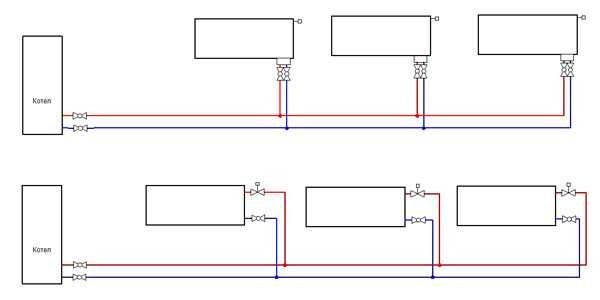
Photo 1. Two options for a two-pipe system: with bottom and side connection of radiators to the heating.
A system connected using a two-pipe system, easier to balance, but the cost of materials when installed it turns out almost twice as much.
Connection methods
Possible ways of connecting aluminum radiators are side and bottom, depending on to which part do the supply and discharge pipes go?
One-sided
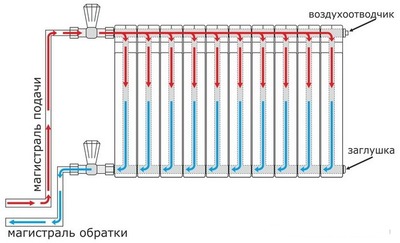
In this case, the pipelines are located on one side of the device.
The supply pipe is on top, the outlet pipe is on the bottom.
Option predominates in high-rise buildings, because it is convenient for the standard passage of the riser on the side of the radiator.
This type of connection is usually used when the number of battery sections is not more than 10, otherwise its far edge will not heat up well.
Important! With a larger number of sections it is possible to install tube - flow extender. It will supply the coolant to the middle part of the radiator.
Diagonal
This option is considered a standard and is taken as a sample when testing heating systems. The coolant goes to the upper inlet on one side of the radiator, and the outlet is located at the bottom on the opposite side.
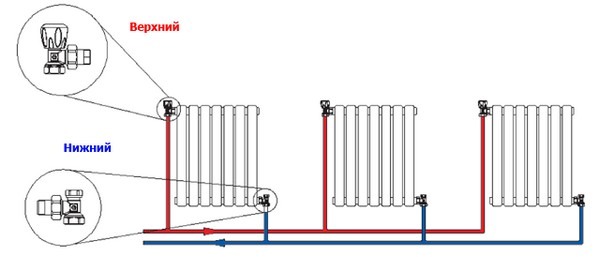
Photo 2. Two-pipe system with diagonal connection of radiators. The upper and lower taps are shown.
In this case, diagonal passage of the coolant through the entire battery and its uniform heating is ensured. With the number of sections in the radiator about 15, the system works optimally.
Attention! The reverse option of side connection (input at the bottom, output at the top) will be a serious mistake and will critically reduce efficiency.
Bottom
Both the supply and return pipes are connected from the bottom. The pipes in this case are hidden in the floor, which makes it the most aesthetic option in terms of appearance. Disadvantage: the radiator may not warm up completely, heat loss reaches 15%.
Selecting a connection method
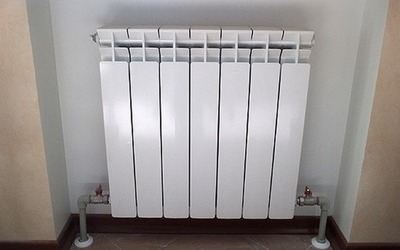
The connection method will depend on the following parameters:
- ease of installation and material consumption;
- ability to regulate heating network;
- number of radiators and sections in them;
- location of risers;
- exterior design heating system.
How to connect correctly yourself
Once the connection method has been determined, it is necessary to correctly pick a place radiator placement. Typical parameters are as follows: height from the floor 8-12 cm, distance from the window sill 10-12 cm, the gap between the device and wall 3-5 cm.
Advice. To prevent the window from fogging up, the radiator area should be not less than 70% of the window opening.
For installation you will need:
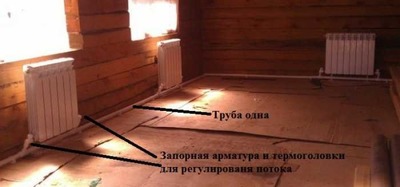
- Mayevsky crane (or automatic air vent);
- plug;
- shut-off valves (two ball or shut-off valves);
- related materials and tools (hooks or brackets for wall mounting, linen winding, sealant, drill with drill bits, level, connecting fittings).
The installation process is as follows:
On the wall, 10-12 cm below the window sill, draw a horizontal line along which the upper edge of the radiator is aligned. Brackets are being installed, usually on dowels. This allows you to adjust the distance to the wall by screwing in and out. The heating device is hung on the fasteners.
Important! There are special brackets for floor installation.
Connection to the pipeline is carried out in accordance with the selected scheme. Pipes of suitable diameter are connected with fittingsA Mayevsky tap (or air vent) and a plug are installed on the free outlets. There are ball valves at the inlet and outlet. or locking with the possibility of adjustment.
All threaded the connections are sealed with linen winding, fum tape, special paste.
Useful video
Watch the video to see what the bottom connection of the radiators looks like.
Be your own master
Connecting an aluminum radiator can be it is quite possible to do it without calling in specialists. It is enough to follow the installation rules and correctly determine the connection schemes in each individual case. A win-win option can be considered a diagonal connection (single- or double-pipe, depending on the material consumption), however the more individual the project, the more variations are possible at the design and installation stage.






